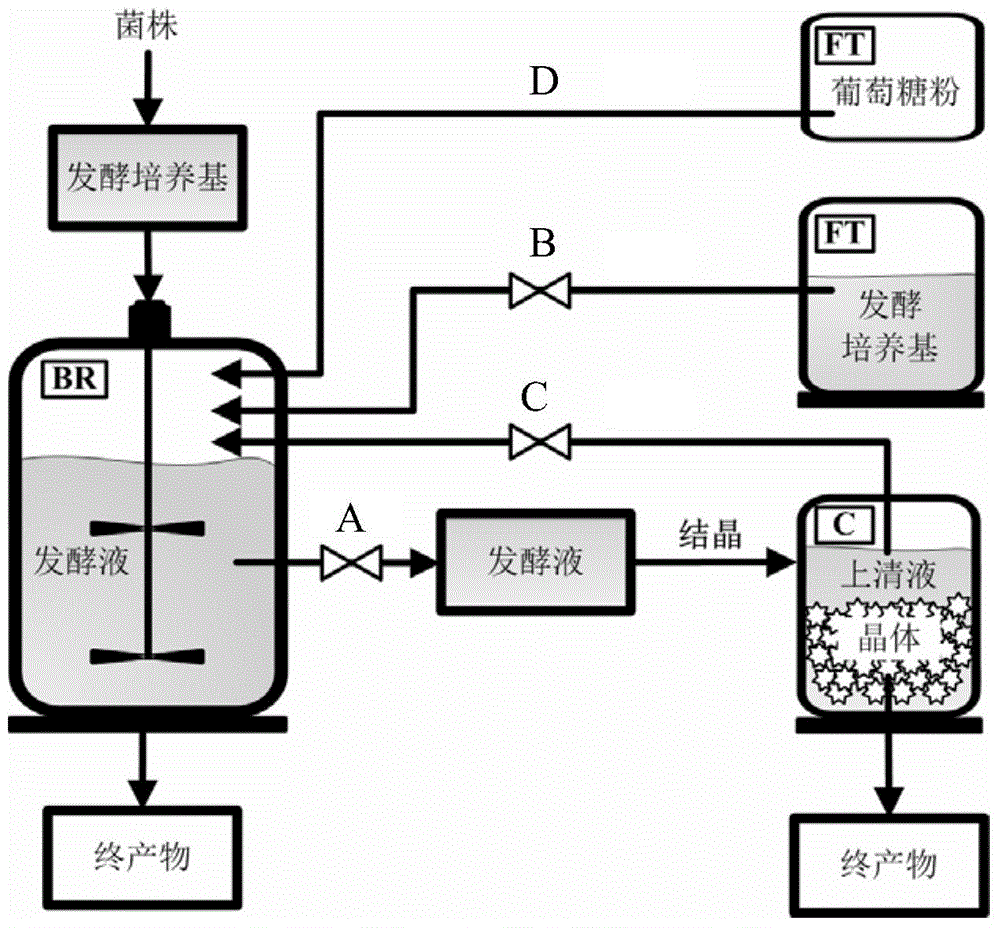Bacillus coagulans and application thereof in calcium lactate production by in-situ product separating and fermentation
A technology for the separation of Bacillus coagulans and in-situ products, applied in fermentation, microbial-based methods, bacteria, etc., can solve the problems of substrate loss, microbial cytotoxicity, and high equipment requirements, and achieve cost savings, low nutritional requirements, and low cost cheap effect
- Summary
- Abstract
- Description
- Claims
- Application Information
AI Technical Summary
Problems solved by technology
Method used
Image
Examples
Embodiment 1
[0041] The composition of medium used in the present embodiment is as follows:
[0042] Slant medium: glucose 10g / L, yeast powder 10g / L, soybean peptone 5g / L, calcium carbonate 5g / L, agar powder 15g / L, pH 6.0.
[0043] Seed medium: glucose 80g / L, yeast powder 10g / L, soybean peptone 5g / L, pH 6.0.
[0044] Fermentation medium: glucose 200g / L, yeast powder 12.6g / L, soybean peptone 1.2g / L, cottonseed protein 3g / L, sodium nitrate 1g / L, ammonium chloride 1g / L, pH 6.2.
[0045] The steps of producing optically pure L-calcium lactate by the open in-situ product separation and fermentation method of the present invention are as follows:
[0046] (1) Slant culture: inoculate Bacillus coagulans H-1 on the slant medium, and culture at 50-60°C for 24-48 hours.
[0047] (2) Seed culture: inoculate the slant culture of step (1) into 30 mL seed medium under sterile conditions, add 40 g / L calcium carbonate to control the pH of the fermentation broth, and culture at 50-60 °C for 10 ~ 24 hour...
Embodiment 2
[0054] The composition of medium used in the present embodiment is as follows:
[0055] Slant medium: glucose 10g / L, yeast powder 10g / L, soybean peptone 5g / L, calcium carbonate 5g / L, agar powder 15g / L, pH 6.0.
[0056] Seed medium: glucose 80g / L, yeast powder 10g / L, soybean peptone 5g / L, pH 6.0.
[0057] Fermentation medium: glucose 200g / L, yeast powder 12.6g / L, soybean peptone 1.2g / L, cottonseed protein 3g / L, sodium nitrate 1g / L, ammonium chloride 1g / L, pH 6.2.
[0058] The steps of producing optically pure L-calcium lactate by the open in-situ product separation and fermentation method of the present invention are as follows:
[0059] (1) Slant culture: inoculate Bacillus coagulans H-1 on the slant medium, and culture at 50-60°C for 24-48 hours.
[0060] (2) Seed culture: inoculate the slant culture of step (1) into 30 mL seed medium under sterile conditions, add 40 g / L calcium carbonate to control the pH of the fermentation broth, and culture at 50-60 °C for 10 ~ 24 hour...
Embodiment 3
[0067] The composition of medium used in the present embodiment is as follows:
[0068]Slant medium: glucose 10g / L, yeast powder 10g / L, soybean peptone 5g / L, calcium carbonate 5g / L, agar powder 15g / L, pH 6.0.
[0069] Seed medium: glucose 80g / L, yeast powder 10g / L, soybean peptone 5g / L, pH 6.0.
[0070] Fermentation medium: glucose 200g / L, yeast powder 12.6g / L, soybean peptone 1.2g / L, cottonseed protein 3g / L, sodium nitrate 1g / L, ammonium chloride 1g / L, pH 6.2.
[0071] The steps of producing optically pure L-calcium lactate by the open in-situ product separation and fermentation method of the present invention are as follows:
[0072] (1) Slant culture: inoculate Bacillus coagulans H-1 on the slant medium, and culture at 50-60°C for 24-48 hours.
[0073] (2) Seed culture: inoculate the slant culture of step (1) into 30 mL seed medium under sterile conditions, add 40 g / L calcium carbonate to control the pH of the fermentation broth, and culture at 50-60 °C for 10 ~ 24 hours...
PUM
| Property | Measurement | Unit |
|---|---|---|
| concentration | aaaaa | aaaaa |
| optical purity | aaaaa | aaaaa |
| optical purity | aaaaa | aaaaa |
Abstract
Description
Claims
Application Information
 Login to View More
Login to View More - R&D Engineer
- R&D Manager
- IP Professional
- Industry Leading Data Capabilities
- Powerful AI technology
- Patent DNA Extraction
Browse by: Latest US Patents, China's latest patents, Technical Efficacy Thesaurus, Application Domain, Technology Topic, Popular Technical Reports.
© 2024 PatSnap. All rights reserved.Legal|Privacy policy|Modern Slavery Act Transparency Statement|Sitemap|About US| Contact US: help@patsnap.com










